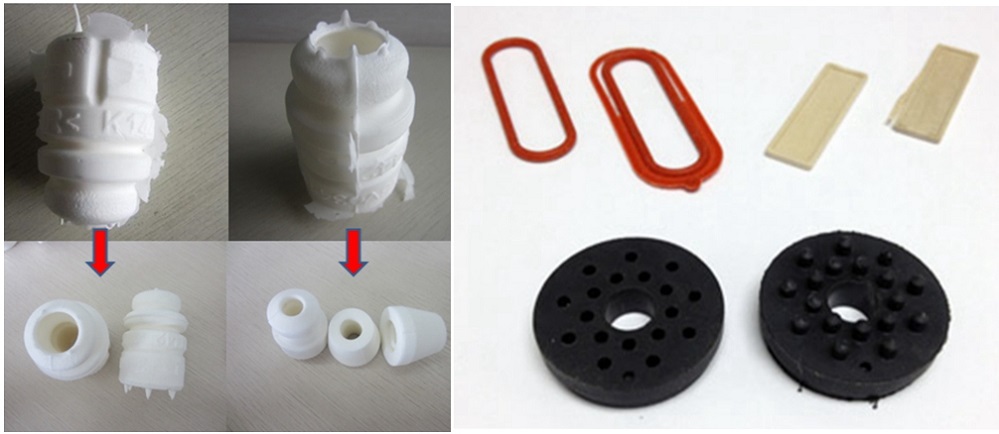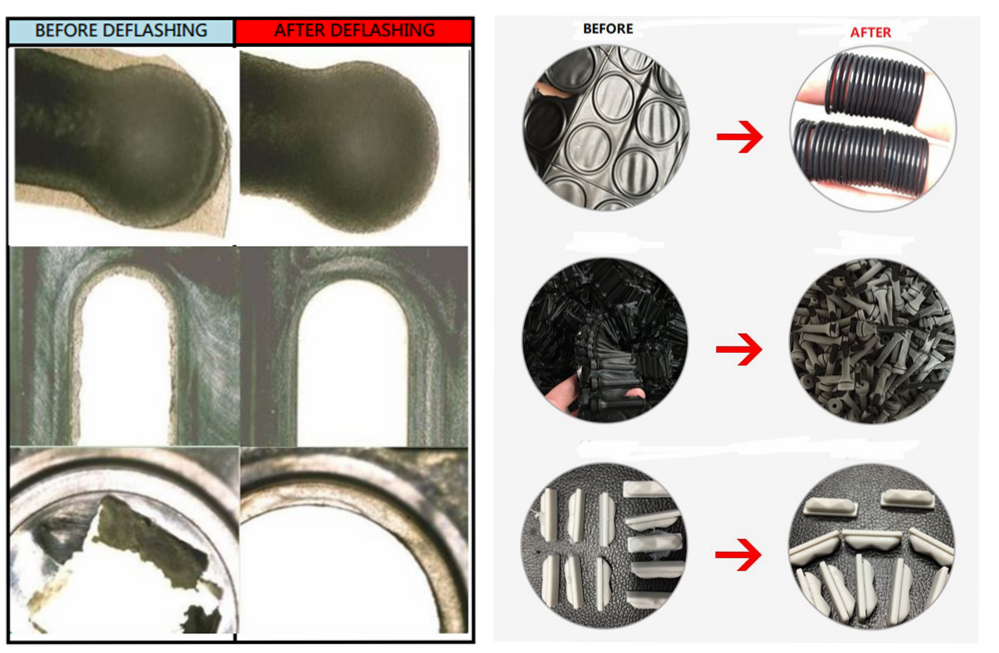Why cryogenic deburring and deflashing are better way for rubber and plastic deburring process?
Why cryogenic deburring and deflashing are better way for deburring process comparing with other traditional methods?
What is Flashes or Burrs, how do they come out?
Flash, also known as Burr, is excess material attached to a molded, forged, or cast product, which must usually be removed. This is typically caused by leakage of the material between the two surfaces of a mold (beginning along the parting line) or between the base material and the mold (in the case of over molding). Molding flash is seen when the optimized parameter on cull height is not calibrated. Proper design of mold parting surfaces can reduce or eliminate flash.
Molding flash can be caused from old or worn mold cavities that no longer fit tightly together. Other times, the complexity of the part requires so many mating pieces with such precise geometries that it is almost impossible to create a perfect fit on every impression. Most often, the type of material being molded, and its attendant viscosity in its liquid form, is the primary factor that leads to the creation of the unwanted mold flash. Check following pictures showing various components having flashes or burrs.

The process of removing flash, known as deflashing or deburring, is commonly performed via cutting, tearing, breaking, grinding, or tumbling. Some foundries use robot auto grinders to remove this unwanted material. It is very typical for molders to have their operators trim flash with hand tools at the molding machine between cycles. Many molders and OEMs seek out the use of batch processes including vibratory tumbling, cryogenic deflashing or media blasting to remove unwanted flash from large batches of parts. Deburring often accounts for a substantial portion of manufacturing costs.
Traditional Types of Deburring
While there are many types of deburring processes, the ones described below are traditional ways which have their obvious disadvantages:
1) Manual Deburring
Manual deburring is the most common type of deburring as it allows for the greatest flexibility. The tools used for manual deburring are generally low in cost,including knives, scissors. Manual deburring allows for instant inspection and generates the best quality without stressing the materials being worked on. Manual deburring is commonly used on rubber or plastics as well as on metals and other materials. The negative sides to this process are the expense of maintaining staff and the possibility of human error.
2) Mechanical Deburring
This is a process that mechanically grinds or sands the burr off a manufactured part. It can be used on materials like rubber or some plastic that do not produce a smooth finish when deburred by hand. This process can be time consuming and the quality of the finish is not guaranteed.
Cryogenic deburring advantages and features for the trimming process
Cryogenic deflashing and deburring is one of the most efficient and least expensive processes used to remove flash from molded parts and machined components.
Using liquid nitrogen, components are lowered to a temperature that allows the material to become brittle. Then, utilizing a cryogenic deflashing machines the flash and burrs are easily removed without altering the finish on the parts. This process can be completed on a wide variety of materials, including rubber, plastic, silicone and light metal die castings. Cryogenic deflashing of rubber and plastic parts removes unwanted residual mold flash that is found on molded parts after removal from the mold. Flash is typically found in areas where the mold comes together or apart, when the liquid mold material escapes from the mold cavity during production. Cryogenic deflashing does not degrade the parts or harm their finish. Only the flash is removed and the shape of the part is retained. Edges stay sharp and recessed areas are completely cleaned of flash. Rubber,Plastics and die-casting parts can be deflashed with great precision.
Cryogenic deflashing operation process is simple and easy to learn, you can understand it with following photo:
.jpg)
Nitrogen media blasting deburring technology features including:
1.Low Cost, the machine can replace the processing ability of 40-60 hand worker, can reduce the number of workers and reduce the deburring cost to the lowest point.
2.High Efficiency, generally, the general type of 60liter capacity cryogenic deflashing machine can process 5kgs of rubber parts/batch and only take 5-7mins. If the G.W of single part is 1g, 42500pcs can be processed in one hour. Will greatly improve the production efficiecnty and save the precious time for the manufacturers.
.jpg)
3.High Processing Precision, if the mold is very good and the flash thickness is below 0.2mm, the processing result will be satisfied. The precision can be up to 0.01mm after deburring. The surface performance is great and feel smooth and the product quality is greatly improved by cryogenic deburring.

Nanjing Pege is one of the most reputed cryogenic deflashing machine supplier in the world range and our machine is recognized by many customers both domestically and internationally. And our quality machines have been highly spoken of by our customers including high quality required regions like Europe countries including Poland, Croatia and Russia. We believe Nanjing Pege will surely be your reliable partner for improving the product trimming process.
If need more information or support, you may contact us by:
Mobile, whatsapp or wechat: +86-13260713283
E-mail: pan_daniel@pegetechno.com


